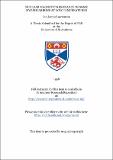Files in this item
Nuclear magnetic resonance in some hydrocarbons at low temperatures
Item metadata
| dc.contributor.advisor | Rushworth, F. A. | |
| dc.contributor.author | Lawrenson, Ian J. | |
| dc.coverage.spatial | 106 p. | en_US |
| dc.date.accessioned | 2018-06-26T13:17:49Z | |
| dc.date.available | 2018-06-26T13:17:49Z | |
| dc.date.issued | 1958 | |
| dc.identifier.uri | https://hdl.handle.net/10023/14615 | |
| dc.description.abstract | The nuclear resonance absorption spectrum of several hydrocarbons has been studied at temperatures down to 20°K, using the bridge method of detection. A special cryostat was constructed for use with liquid hydrogen. In the case of cyclopentene, experimental evidence has been found in favour of a non-planar molecule, rotating about an axis perpendicular to the plane defined by four of the carbon atoms. This motion starts near 87°k, the temperature of the reported specific heat transition. At 124°k, the molecules appear to diffuse through the lattice, so that at 128°k, 10° below the melting point, the line width is less than the field inhomogeneity. Measurements of the second moments of n-pentane, n-hexane and n-octane indicate reorientation of the methyl groups about the end C-C axes, even at 20°K. an approximate value for the height of the barrier restricting the rotation in the n-octane molecule has been determined from the spin-lattice relaxation time measurements. Second moment measurements on cyclooctatetraeene have provided strong evidence in favour of a "tub" (D2a) structure of the molecule, with conjugated double and single bonds. | en_US |
| dc.language.iso | en | en_US |
| dc.publisher | University of St Andrews | |
| dc.title | Nuclear magnetic resonance in some hydrocarbons at low temperatures | en_US |
| dc.type | Thesis | en_US |
| dc.type.qualificationlevel | Doctoral | en_US |
| dc.type.qualificationname | PhD Doctor of Philosophy | en_US |
| dc.publisher.institution | The University of St Andrews | en_US |
This item appears in the following Collection(s)
Items in the St Andrews Research Repository are protected by copyright, with all rights reserved, unless otherwise indicated.

